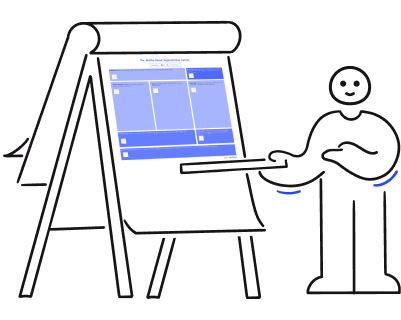Do you have any idea of the time that elapses between a new course idea and its publication?
In most cases, the answer is: too long. But why is it taking so long?
Here are some popular reasons:
- “I'm running out of time to complete my project.”
- “I don't know where to start.”
- “I want everything to be perfect.”
All of the above are excuses to remain inactive. We take comfort in procrastinating under the cover of perfectionism when it is not the real problem.
The reason behind your delay is that you have not yet found the right technique for project management. That's all!
By adopting more agile strategies, you would see the results of your efforts faster. You would be constantly in action, which would decrease the time between your first idea and the publication of your course.
Empower your organization with the skills-based canvas.

What's in this article
I invited Geneviève Dicaire, founder and professional coach at Unique coaching, to share with us her vision of the agile method:
Agile project management has proven itself since the beginning of the 2000s. It is more concrete since it forces us to deliver increments, or tangible deliverables, every 10 days or so.
The goal is not to be “perfect”, the goal is to test and adjust. The more concrete results we see, the more motivation is present to deliver (this prevents procrastination 😉).
Besides, we are more efficient, because we do not waste time delivering a perfect thing that eventually has to be done again if does not reach our objectives...
So? Do you have a project you would like to upload soon?
Let me show you how you could publish your online course faster with agile project management!

Prepare your project management
The first thing to do with your course idea is to transform it into a project proposal.
Why? Because it helps you to better define your concept and to make it something more concrete.
In your project proposal, you should include:
- The theme of your training
- The overall objective and the specific objectives
- The audience targeted by your course
Some key concepts that should be included in your course outline
Geneviève Dicaire adds that to go even further in the use of the agile methodology, the vision should be included. This means responding to:
- At the end of the training, what do I want the participant to have learned?
- How would I like him/her to feel?
In an agile model, the meaning (why we do things) is central. It is essentially what must not change. The course could have more or fewer modules, questions, documentation, video while respecting the vision.
This is what gives freedom.
Having these elements well defined, it will be much easier to start your agile project management plan.
What is the agile method?
As the name suggests, agile project management is in constant motion. It is not linear and continuously evolves to better adapt to the needs of the end-user.
This approach is characterized by the division of tasks into short phases and the frequent reassessments and adaptations of plans. These phases of development are commonly called sprints.
In other words, the route and destination can change along the way!
The big advantage of this method is that you don't have to do everything all at once. You can divide your project to achieve tangible results faster, then measure and analyze.
As you progress through the following phases, your previous phases are already published and used! With this data, you can make improvements as you go rather than waiting for the end of the project.
Agile project management in an online course context
The theory is all well and good, but how does it apply in practice?
First, we must stop seeing a training project as a big block of stages dependent on each other. It's a false belief to think that everything must be done before publishing your course - on the contrary!
There are several ways to split your project into sprints and thus get faster to a tangible result. Here are some examples:
- Document your training preparation and share your progress with your subscribers. This allows you to create a pool of potential customers upstream and promote your content. At the end of your research and analysis process, you will already be able to validate the interest of your target market!
- Test your content in public. Before moving on to recording your sessions, you can organize one or a few virtual classes to practice. Although the formula is not the same, it will allow you to become comfortable in front of the camera. You'll also have real-time feedback on what to improve!
- Build a group of testers with your potential customers. Rather than asking your parents or friends to rate your content, invite your customers to do so. Find a few people to give VIP access to your course in beta. If you involve them in your project, they will even become its ambassadors!
According to Geneviève Dicaire, this technique is of the utmost importance:
Another goal of agility is to focus on what is relevant. When testing, and in front of the target group, the feedback can only be fair. Being agile also means working with others to create value.
Tests can be confrontational, that is to say, confront us in our methods or our priorities. Being agile also means being open to the opinions of others!
The more we create to offer value to our target, the more successful our course will be.
- Don't worry about creating content. Start by working with what you have to publish your course faster. Focus on the quality of your content rather than the format. A PDF lesson can become a text lesson and even a video lesson over time!
- Offer a la carte micro-courses. If you plan on offering a course with multiple modules, you could start by creating smaller courses temporarily. By posting your content faster, you will collect feedback and be able to adjust the focus.
Of course, these are just a few ideas. Depending on your project and your goals, you can choose the best sprints to work on.

Take action!
Agile management, beyond the fact that it has become a buzzword, it's much simpler than you think.
We have found that you can easily speed up the time between ideation and publication of your course. You have no more excuses to postpone the start of your project!
For Geneviève Dicaire, “there is nothing better than action to motivate yourself”! This is why she reminds us to apply the following methodology:
- Determine the vision
- Determine the first step and the deliverables included
- Test everything
- Adapt and continue!
So, what are you waiting for to launch your first online training?
Discover, manage, and grow your team’s skills to unleash their potential and retain your rising stars.




